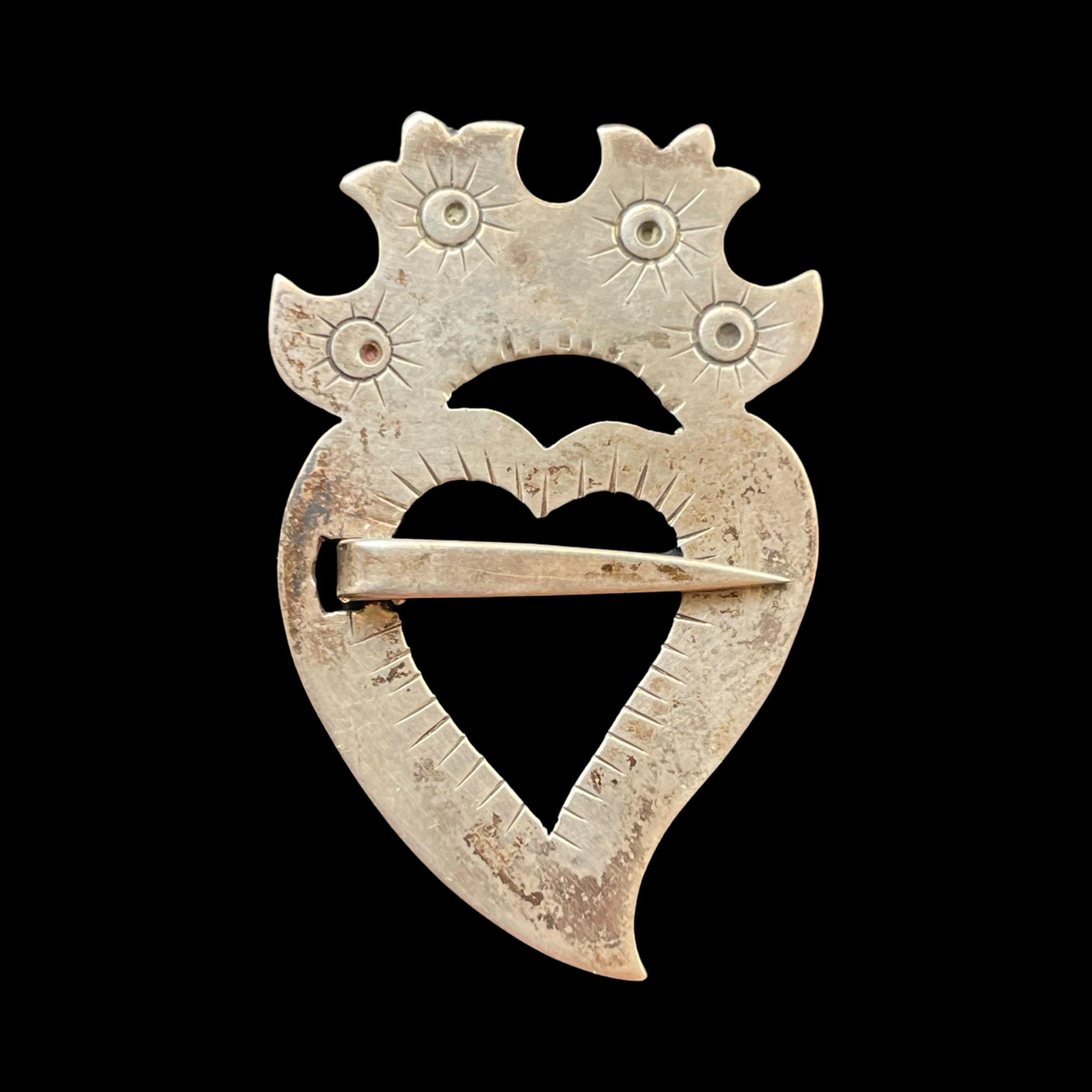Luckenbooth Brooches
Sometimes the eye will be drawn to something that resonates with the spirit even if the mind is not fully aware of its meaning or purpose.
This is a tale about a captivating piece of jewelry and a mystery that obscured its meaning until The House’s eyes were opened. So buckle in for a wild ride….
A few years ago, The House collected a little heart-shaped piece of silver from a dealer who described it as a “tiny buckle.” The form was reminiscent of a Sacred Heart, and even though the seller’s description didn’t make sense, sometimes one just goes with the flow.
And so, without further thought, the “little buckle” was stashed along with the rest of the collection .
Silver Heart Brooch, House of Good Fortune Collection
Silver Heart Brooch (reverse), House of Good Fortune Collection
Then one day The House encountered an interesting post on Instagram…
Something seemed…familiar…about the form —- a heart with a crown, and that distinctive fastener.
And as it happens from time to time, The House went down an internet rabbit hole that led to this blog post.
***
Please allow The House to weave a tale of the Luckenbooth brooch. The form is as old as the hills and as deep as the lochs. Born in the heart of Scotland, within the bustling Luckenbooths of Edinburgh’s Royal Mile, these brooches are symbols of love and protection, as enduring as the stone of the ancient cathedrals.
The Luckenbooth (literally “locking booth”) is a cherished love token from the Scottish Highlands. Often adorned with a crown resting above one heart or two entwined, they were the work of silversmiths, sold in lockable stalls. An example from Inverness, circa 1800, is below.
The brooch dates back to the 17th century (at least) and its fastener differs from that of modern brooches. The Victoria & Albert Museum explains, “The wearer pulls the cloth of the garment through the central hole, and then spears it with the pin. The greater the strain on the pin, the more secure the fastening.”
While the brooch was commonly given as a pledge of affection, the luckenbooth was also used as a charm for nursing mothers, or a shield for babes against the evil eye, which is why luckenbooths are sometimes called “witches’ brooches”.
(As an aside…a heart that curves on one side, usually the right side, is often referred to as a “witch’s heart” and is meant to protect the wearer against evil spirits. )
It’s said that Mary Queen of Scots bestowed a Luckenbooth upon her beloved Lord Darnley, a symbol of her own heart crowned with loyalty. Another tale spun that it was an engagement brooch bestowed upon her by the Dauphin of France, whom she later married.
And so this style f brooch became a common betrothal or wedding gift, holding within it the promise of love and protection. But fate had other plans for this silver emblem…and eventually it would find its way across the Atlantic Ocean to The New World.
Luckenbooths in North America
In the 18th century, ships sailing across the Atlantic carried more than cargo and crew. They bore stories, traditions, and treasures. Among these treasures were Luckenbooth brooches, their hearts beating with memories of Edinburgh’s bustling Royal Mile.
These silver brooches found a new home among the indigenous peoples of the Eastern Woodlands, particularly the Iroquois Nations. The Iroquois, with their own rich cultural heritage, embraced the Luckenbooth as a symbol of love, devotion, and protection. They pinned it to their clothing, weaving the form into their attire, and it became a common decorative motif—a bridge between distant lands. The heart and crown motifs resonated across cultures, transcending oceans and language. Perhaps the Iroquois saw the heart as a vessel for love and the crown as a symbol of sovereignty?
The House’s exploration led to a website called Random Treasure, which laid out the clues that led to The House’s epiphany — the “little buckle” was likely a Luckenbooth! And it was probably from North America rather than Scotland. It was all starting to make sense. Joy, the dealer who sold the “buckle,” deals primarily in traditional Native American jewelry, and this little piece must have found its way into her collection, perhaps as part of a lot she bought at auction?
The House’s piece bears the marks “Arrocraft” and “Sterling” but unfortunately, The House was unable to uncover any information about the maker…until four months after posting this blog when The House got a note from Lynne R., an astute reader who shared some helpful information that shed light on the likely origins of this piece.
Arrocraft was a “cottage industry” of the Arrowmont School of Arts and Crafts in Gatlinburg, Tennessee (established in 1912 as the Pi Beta Phi Settlement School). So it seems that this piece was probably fashioned as part of the school’s metalworking program in the 1970s or 1980s.
So, dear readers, when you see a Luckenbooth brooch, remember its journey—from the cobbled streets of Edinburgh to the forests of North America. It carries not only silver and stone but the enduring threads of love and loyalty, woven into a timeless tapestry of shared cultural heritage.
Further Reading:
The Luckenbooth: Scotland’s Love Brooch, The New York Times, November 30, 2018
Luckenbooths, Ediburgh, Scotland, Atlas Obscura
Random Treasure: A Website about Antiques, Auctions and Alchemy, by Roger Stewart
History of Heart-Shaped Jewelry, Worthpoint








